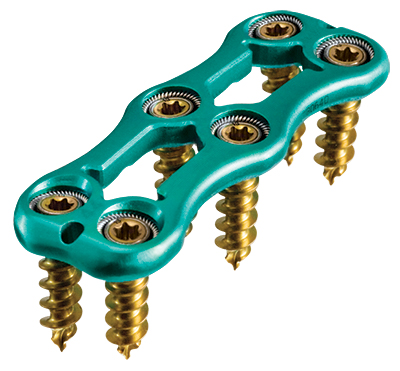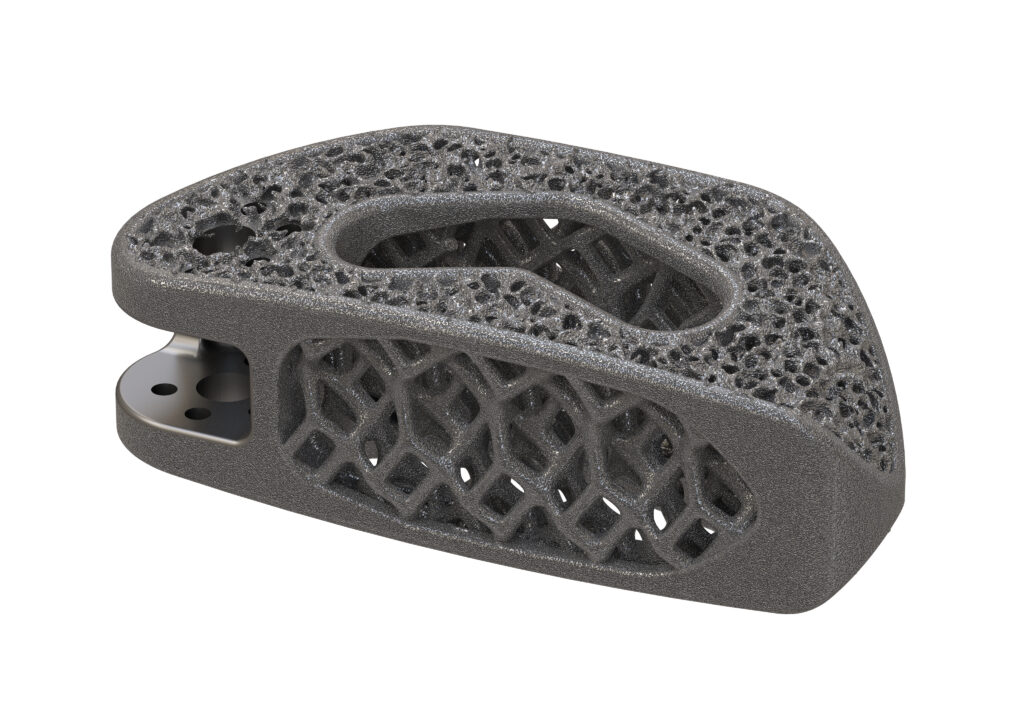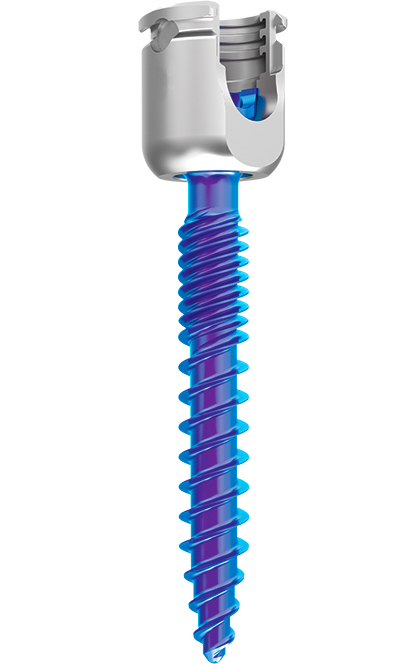
Example of a plate that is used for fusion (healing together of the bones) of the cervical spine (neck) from an anterior (front of the neck) surgical approach. The plate spans one or more disc spaces and the screws anchor it into the vertebral bones of the neck. This immobilizes the spine segment and facilitates the bones healing together (fusion) across the disc space(s).

Example of a spacer that can be inserted between the vertebral bones (interbody) after a disc has been removed. This specific type of spacer is inserted from the back of the spine as part of a procedure called a transforaminal lumbar interbody fusion (TLIF).

Example of a pedicle screw. These screws are inserted into the bony structures called the pedicles that are along the sides of the vertebra. Two of these screws are often placed into each vertebral bone of the spine (one on the left and one on the right) across the levels that are being fused. Rods can then be contoured to fit into and connect the heads of the screws on each side of the spine, with locking caps then placed to secure the rod to each screw heads. This enables immobilization across the spinal levels to help facilitate fusion (healing together) of the bones the metal spans.
What are spinal implants?
Spinal implants are medical devices used during surgery to treat deformities, stabilize and strengthen the spine, and facilitate fusion. Disorders that can be treated by the insertion of spinal implants include:
- Degenerative disc disease (wear and tear on spinal disc)
- Spondylolisthesis (slippage of a vertebral bone on an adjacent vertebral bone)
- Scoliosis (sideways curvature of spine)
- Kyphosis (excessive forward rounding of back)
- Fractures
Fusion spinal implants
Spinal Implant 3Spinal fusion is a procedure where the surgeon combines two or more vertebrae by inserting secondary bone tissue to increase the bone healing process and have them fuse together. The bone graft can either come from the patient (autograft) or from another person (allograft).
Spinal implants used in fusion include cages, plates, and screws and rods. Cages (or interbody spacers) are placed inside the empty space (created from removing an affected intervertebral disc) between two vertebrae. With a hollow center filled with bone-growth promoting material, bone can grow through the cage (and around it) and it eventually becomes part of the spine. This adds stability and support to the spine after surgery.
Plates are attached to the vertebrae with screws and also assist in stabilizing the spine. Plates are most commonly used when doing surgery from the front of the spine. For example, plates are often used when performing surgery from the front of the neck (see section on ACDF) or sometimes when performing removal of disc from the front of the lumbar spine.
Screws and rods help to stabilize the spine. Screws in the thoracic (chest area) and lumbar (lower back) parts of the spine are most commonly placed in the pedicles of the vertebra. The pedicles are the parts of the vertebra that connect the front and back portions of the bone together. The screws provide multiple points of anchorage into the vertebra. The screw heads are cup-shaped rods are bent to capture the screw heads and lock onto them to provide stability across two or more vertebra.
What are these spinal implants made out of?
These spinal implants can come in all shapes, sizes, and heights to accommodate any patient. They’re also body-friendly and made out of materials such as:
- Titanium: a lightweight, high strength, corrosion resistant metal that’s been widely used for spinal reconstruction since its introduction in 1986. It has good flexibility and promotes bone growth pretty well. They can also be seen very well in MRI scans.
- Polyethylene: The most commonly used plastic today. Made up of long molecular chains that can transfer loads and provide high impact strength to the implants, especially artificial discs
- Cobalt-chrome: A strong, rigid, corrosion resistant alloy metal formed by mixing together cobalt and chromium metals
- Stainless steel: While other materials are better suited to react to compressive loads, this mixture of iron and carbon can produce very strong implants.
We only utilize the best implants for our patients. If you have any questions, comments, or concerns about these amazing medical devices, feel free to contact us through our website.

